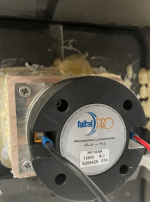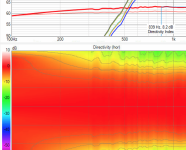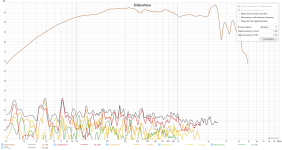I'll have to brush up on my REW.
Moving the mic closer (1m from HF10AK) shows the usual suck at 2k.
1 meter from CD, roughly 11.25 deg intervals

1m on axis distortion

Moving the mic closer (1m from HF10AK) shows the usual suck at 2k.
1 meter from CD, roughly 11.25 deg intervals
1m on axis distortion
@TNT here is ~ 96dB @ 1m
22.5deg horizontal off axis
I need to check the CD mount and make sure we’re screwed down and properly flush.

22.5deg horizontal off axis
I need to check the CD mount and make sure we’re screwed down and properly flush.
Last edited:
"Voice Coil Test Bench" Methodology
"As explained in other characterizations, the level was set at 1m (104dB is my standard for pro sound drivers), the mic is then relocated to 10cm to make the measurement, which explains the 120dB. This is done so the ratio of direct energy from the driver is substantially greater than energy from the room, a requirement for distortion measurements not made in an anechoic chamber."
I suppose I could try that. Ear buds + defenders required.
"As explained in other characterizations, the level was set at 1m (104dB is my standard for pro sound drivers), the mic is then relocated to 10cm to make the measurement, which explains the 120dB. This is done so the ratio of direct energy from the driver is substantially greater than energy from the room, a requirement for distortion measurements not made in an anechoic chamber."
I suppose I could try that. Ear buds + defenders required.
Building the CD high pass on the bread board
~ 820Hz 24dB LR4
Tried to maintain a fairly flat impedance.
Any comments welcomed.

~ 820Hz 24dB LR4
Tried to maintain a fairly flat impedance.
Any comments welcomed.
No smoothing.
I've tried to squash the the 2k dip in the HF10AK to a +/- 2dB bump between 1.7 & 4k by pulling frequencies down to the low point as best as I can with minimal passives.

I've tried to squash the the 2k dip in the HF10AK to a +/- 2dB bump between 1.7 & 4k by pulling frequencies down to the low point as best as I can with minimal passives.
I have not finished the cabinet, it is not sealed properly yet as I'm working on the "maintainence door on the bottom" of the cabinet.
A quick look at a 1/2 octave multi tone.
mic positioned, level in Z to throat, 50cm from throat, 20deg off axis.
Crossover 800Hz, LR4.


A quick look at a 1/2 octave multi tone.
mic positioned, level in Z to throat, 50cm from throat, 20deg off axis.
Crossover 800Hz, LR4.
Last edited:
a little more scientific
protection : 22uF with 9dB/8ohm resistor pad
0 to 110
10 degree increments
500 radius from baffle front face
no EQ

I've fallen a bit out of love with the HF10AK.
Its 2k suck is hard to develop an analog XO for.
I'm not sure what's happening at 11.5k & 17k.
HF108R (31deg exit) and HF109 (13deg exit) on the way to try out.
They both seem to behave better at 2k.

protection : 22uF with 9dB/8ohm resistor pad
0 to 110
10 degree increments
500 radius from baffle front face
no EQ

I've fallen a bit out of love with the HF10AK.
Its 2k suck is hard to develop an analog XO for.
I'm not sure what's happening at 11.5k & 17k.
HF108R (31deg exit) and HF109 (13deg exit) on the way to try out.
They both seem to behave better at 2k.
Last edited:
Hi,
while the 2kHz dip is not ideal it's not too bad. You could experiment if you hear a difference boosting it with DSP EQ to make peace of mind with it 🙂 If you find it something bothering all things considered, then by all means change driver, but I suggest comparing another driver in some kind of AB test setup, this is good thing to do no matter what drivers you had. Just evaluate fairly, if responses differ then perhaps it's not that either sounds worse or better always, but just in your application 😉 for absolute evaluation, be sure to match frequency responses within .5db, job for a DSP.
Anyway, I'm not sure if HF10AK is ideal for that that low of a crossover, I think mine sounds better crossed above 1kHz and no special treatment for the 2kHz dip, but the "grainy" sound I think I hear could be from anything, including my test setup or anything, from the source material and my ear picking it up or something. I haven't done comprehensive testing regarding this, anyway, a hunch I thought to share. Please evaluate yourself.
But yeah, it's a tricky one, response quite bumpy but not an issue for DSP. I'm not sure how people make these work with passive XO, many db peaks / dips are very audible and sound gets much better if flattened out. Perhaps sound got from good to best?😀 Parts count skyrockets anyway.
Anyway, here is something you could experiment with.
If you use a series cap it reduces electrical damping and you'd get peaks where the impedance peaks are. This makes apparent boost ~1-2kHz which makes the 2kHz dip seem worse. This is my old measurement of HF10AK in STH100 horn.
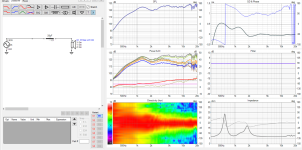
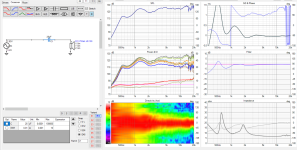
If you used parallel coil instead, you'd not reduce electrical damping almost at all, but this would short low frequencies so series resistor before is a must to limit current. This is not a problem though, as you need pad it anyway, but heat could be a problem if you listen always very loud.
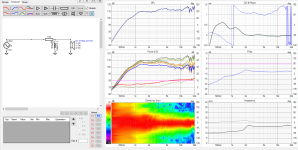
Nice, not so bad dip anymore. Then, add also series coil to tilt the response down and take down peak about 4kHz with a notch filter.
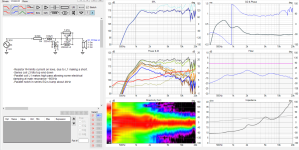
Not sure if this is any better than what you have now, or how it would work with your waveguide and plan of a crossover. Peak around 1.3kHz should be fixed somehow, with conjugate perhaps, or some clever trickery. Anyway, an example of a passive crossover where the 2kHz dip is not much of an issue anymore.
while the 2kHz dip is not ideal it's not too bad. You could experiment if you hear a difference boosting it with DSP EQ to make peace of mind with it 🙂 If you find it something bothering all things considered, then by all means change driver, but I suggest comparing another driver in some kind of AB test setup, this is good thing to do no matter what drivers you had. Just evaluate fairly, if responses differ then perhaps it's not that either sounds worse or better always, but just in your application 😉 for absolute evaluation, be sure to match frequency responses within .5db, job for a DSP.
Anyway, I'm not sure if HF10AK is ideal for that that low of a crossover, I think mine sounds better crossed above 1kHz and no special treatment for the 2kHz dip, but the "grainy" sound I think I hear could be from anything, including my test setup or anything, from the source material and my ear picking it up or something. I haven't done comprehensive testing regarding this, anyway, a hunch I thought to share. Please evaluate yourself.
But yeah, it's a tricky one, response quite bumpy but not an issue for DSP. I'm not sure how people make these work with passive XO, many db peaks / dips are very audible and sound gets much better if flattened out. Perhaps sound got from good to best?😀 Parts count skyrockets anyway.
Anyway, here is something you could experiment with.
If you use a series cap it reduces electrical damping and you'd get peaks where the impedance peaks are. This makes apparent boost ~1-2kHz which makes the 2kHz dip seem worse. This is my old measurement of HF10AK in STH100 horn.


If you used parallel coil instead, you'd not reduce electrical damping almost at all, but this would short low frequencies so series resistor before is a must to limit current. This is not a problem though, as you need pad it anyway, but heat could be a problem if you listen always very loud.

Nice, not so bad dip anymore. Then, add also series coil to tilt the response down and take down peak about 4kHz with a notch filter.

Not sure if this is any better than what you have now, or how it would work with your waveguide and plan of a crossover. Peak around 1.3kHz should be fixed somehow, with conjugate perhaps, or some clever trickery. Anyway, an example of a passive crossover where the 2kHz dip is not much of an issue anymore.
Last edited:
took out the 22uf and pad
amp direct to hf10ak now
in REW exported frd 1/24 smoothing
96 samples per octave

amp direct to hf10ak now
in REW exported frd 1/24 smoothing
96 samples per octave
Last edited:
Last edited:
If all goes well, tomorrow I will try a Wom300_vDIY for sealed Qtc 0.62
https://www.kartesian-acoustic.com/wom300-vdiy
STATISTICS
f3 77.7 Hz
f6 56.6 Hz
f10 41.8 Hz
Zmin 5.3 Ohm @ 39793.9 Hz
Zmax 54.2 Ohm @ 67.3 Hz
GDmax 3.5 ms @ 43 Hz
XmaxC 1.1 mm @ 5 Hz
Pmax 1.5 VA @ 39793.9 Hz
-------------------------------------------------------------
DRIVER: Kartesian Wom300_vDIY, 1 pcs in series
n0 1.18 % Reference efficiency
SPL 92.9 dB/W Sensitivity
USPL 94.6 dB/2.83 Sensitivity
EBP 97.6 Efficiency bandwidth product
Dd 25.5 cm Effective diameter of driver
Vd 306.6 cm^3 Maximum linear volume of displacement
Cas 6.44E-7 m^5/N Acoustic equivalent of Cms
Mas 2.87E1 kg/m^4 Acoustic equivalent of Mms+Mme
Ras 9.28E2 Ns/m^5 Acoustic equivalent of Rms
Rae 1.76E4 Ns/m^5 Acoustic equivalent of Re
-------------------------------------------------------------
BOX REAR 1: Vb=39.2 l, Ql=15.0
Fb 67.4 Hz System resonance frequency
Cab 2.78E-7 m^5/N Acoustic compliance of air in enclosure
Rab 4.25E2 Ns/m^5 Acoustic resistance due to absorption
Ral 1.28E5 Ns/m^5 Acoustic resistance due to leakage
Qtc 0.62 Total Q factor

https://www.kartesian-acoustic.com/wom300-vdiy
STATISTICS
f3 77.7 Hz
f6 56.6 Hz
f10 41.8 Hz
Zmin 5.3 Ohm @ 39793.9 Hz
Zmax 54.2 Ohm @ 67.3 Hz
GDmax 3.5 ms @ 43 Hz
XmaxC 1.1 mm @ 5 Hz
Pmax 1.5 VA @ 39793.9 Hz
-------------------------------------------------------------
DRIVER: Kartesian Wom300_vDIY, 1 pcs in series
n0 1.18 % Reference efficiency
SPL 92.9 dB/W Sensitivity
USPL 94.6 dB/2.83 Sensitivity
EBP 97.6 Efficiency bandwidth product
Dd 25.5 cm Effective diameter of driver
Vd 306.6 cm^3 Maximum linear volume of displacement
Cas 6.44E-7 m^5/N Acoustic equivalent of Cms
Mas 2.87E1 kg/m^4 Acoustic equivalent of Mms+Mme
Ras 9.28E2 Ns/m^5 Acoustic equivalent of Rms
Rae 1.76E4 Ns/m^5 Acoustic equivalent of Re
-------------------------------------------------------------
BOX REAR 1: Vb=39.2 l, Ql=15.0
Fb 67.4 Hz System resonance frequency
Cab 2.78E-7 m^5/N Acoustic compliance of air in enclosure
Rab 4.25E2 Ns/m^5 Acoustic resistance due to absorption
Ral 1.28E5 Ns/m^5 Acoustic resistance due to leakage
Qtc 0.62 Total Q factor
- Home
- Loudspeakers
- Multi-Way
- ATH4 waveguide inspired multi way
